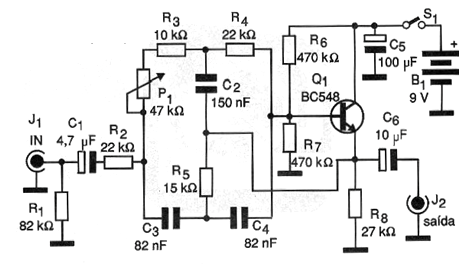The 60 Hz hum or noise from the power grid (hum, in English) is one of the biggest enemies of sound system operators and installers. Wires, long cables and the same poorly shielded equipment capture the signal radiated by the wiring of the power network, amplifying it. The result is the unpleasant snoring reproduced by the speakers. The circuit we present is a 60 Hz filter or eliminator (which can also be modified to reject other frequencies that may eventually disturb a circuit). This filter is interspersed between the snoring source (for example, a long microphone cable) and the preamplifier, mixer or amplifier. In the figure we have the complete diagram of our snoring filter. This filter consists of an amplifying step with a transistor with strong negative feedback at the frequency determined by the resonance of the double T. This double T can be fine-tuned in P1 to find the exact rejection point according to the normal tolerances of the components. This means that, for frequencies out of adjustment, the circuit acts as a pre-amplifier, but does not amplify the signal at the adjusted frequency. The input impedance of the circuit is given by R1 and allows its use with high impedance sources, such as microphones or the output of common preamps.




